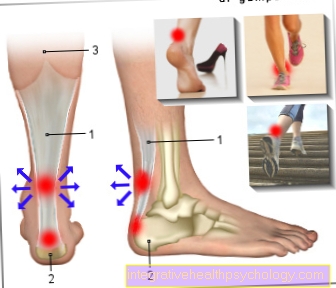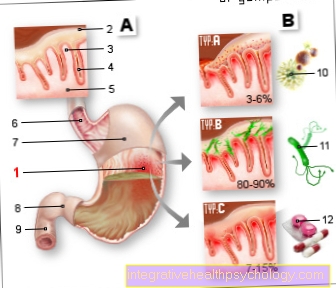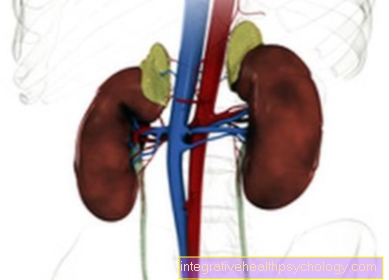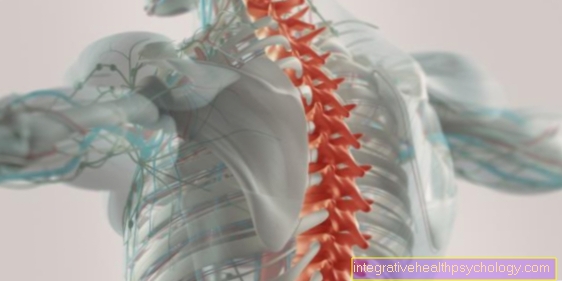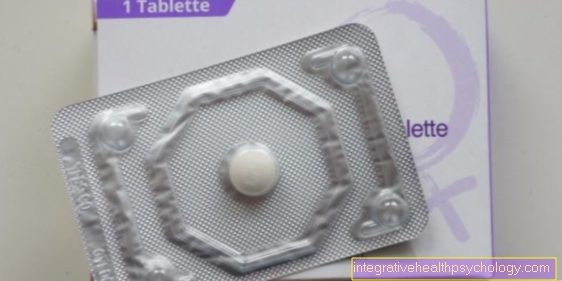Appendicitis in Pregnancy
introduction
Appendicitis (appendicitis) is a serious condition that requires treatment that occurs in around one in a thousand pregnancies. The cause is inflammation of the appendix (appendix) of the appendix (Caecum).
It is crucial that the disease is recognized and treated in good time, which usually requires surgical removal of the appendix. With timely treatment, a danger to mother and child can usually be averted. A particular difficulty of appendicitis in pregnancy is that the main symptom of right-sided lower abdominal pain due to a displacement of the appendix often does not occur.

How dangerous is that
If it is recognized and treated in good time, appendicitis during pregnancy usually has no long-term consequences for mother and child. However, if the disease is diagnosed too late or not treated quickly enough, in the worst case scenario, both of them are in danger.
An increasing inflammatory reaction of the appendix of the appendix can ultimately lead to a breakthrough of the organ, so that pus and stool penetrate into the abdominal cavity. This leads to peritonitis which, if left untreated, can lead to the death of both mother and child. It is therefore important to take signs of appendicitis seriously and, if in doubt, to get a medical examination at an early stage.
It should be noted, however, that many of the possible signs of appendicitis are non-specific and occur more often during pregnancy due to harmless causes. These include, for example, nausea and back pain. In order to avert the potentially dangerous course of appendicitis, one should therefore pay attention to the signals of the body (without being constantly worried about a serious illness) and, in case of uncertainty, seek the advice of a doctor in good time.
Signs
The first signs of appendicitis during pregnancy are usually very unspecific and can also occur due to a harmless cause. Abdominal pain, which often begins in the area of the navel and cannot be precisely localized, is typical. As the pain progresses, it often moves to the right.
In non-pregnant women and in the first months of pregnancy, the pain typically migrates to the right lower abdomen and can be precisely localized there. In the course of pregnancy, the intestines including the appendix are pushed upwards by the growing uterus, so that the pain can also be higher.
In addition to a wandering of pain, a change in the character of the pain from dull to piercing and light is typical. With some pregnant women, however, the pain is mainly felt on the back. Since back pain is a common symptom with mostly harmless causes, especially during pregnancy, it can be difficult to distinguish it from a sign of appendicitis. In most cases, however, additional signs such as fever, nausea and vomiting occur.
Anyone who is unsure whether they have symptoms of appendicitis should see their gynecologist. In the case of increasing and pronounced complaints, an emergency presentation to a doctor or direct notification of the emergency services is indicated.
More information on this at: Signs of appendicitis
Symptoms
The symptoms of acute appendicitis in pregnancy are primarily abdominal pain on the right side. At the beginning of pregnancy these usually move from the middle to the right lower abdomen. From about the 28th week of pregnancy, the ever larger uterus leads to an increasing displacement of the appendix into the upper abdomen, so that the pain can also be localized there.
Other possible symptoms are loss of appetite, nausea, and vomiting. Fever also frequently occurs, with the difference between the temperature measured in the rectum and the temperature measured in the mouth typically being increased. As the disease progresses, the symptoms usually increase and can even lead to board-like tension in the abdominal wall.
It is particularly dangerous if the pain suddenly subsides, as this symptom can indicate a rupture of the appendix. Then, at the latest, the operation must be performed as soon as possible. In general, symptoms such as new or increasing abdominal pain during pregnancy should therefore be clarified at an early stage by a medical examination.
You might also be interested in this topic:
- Abdominal pain in pregnancy
- This is how you can recognize appendicitis
Surgery in pregnancy
An operation for appendicitis is possible and often necessary to achieve a cure. The procedure increases the risk of miscarriage or premature birth, but without an operation it can be life-threatening for the mother and therefore also for the child.
In principle, the most frequently used procedure during pregnancy can be the "keyhole technique" (laparoscopic) as well as the conventional open procedure via an incision above the right groin. In general, the laparoscopic procedure offers some advantages, which is why it is nowadays chosen much more often for appendicitis. In addition to faster wound healing and fewer wound healing disorders, the remaining scars are only very small.
During pregnancy, however, the risk of premature birth is slightly higher with this procedure, so that the open procedure is chosen more often. However, the risk of miscarriage is the same for both procedures.
Read more about this: OP of appendicitis
causes
The causes of appendicitis in pregnancy are usually no different from those in patients who are not pregnant. The appendix of the appendix is tubular, only a few millimeters in diameter and ends blind. If intestinal bacteria penetrate the wall of the appendix, they can trigger an inflammatory reaction.
One possible cause is, for example, that the opening of the appendix of the appendix is blocked by a small fecal stone, for example. Another trigger are gastrointestinal infections, which can trigger appendicitis. In addition, the appendix can kink. It is believed that this cause often leads to the development of appendicitis due to the displacement of the intestine by the growing uterus, especially during pregnancy.
diagnosis
The diagnosis of appendicitis is generally based on the clinical assessment of the surgeon and is also made during pregnancy. This means that the doctor uses the patient's condition, the findings from the physical examination, and the symptoms presented to assess whether appendicitis is likely.
Further diagnostic measures such as a blood test or ultrasound can only help but in no way lead to the exclusion or evidence of the disease.
The diagnosis can ultimately only be confirmed as part of the operation and, if necessary, through the tissue examination of the removed appendix.
Duration
Appendicitis during pregnancy usually develops within a few hours to days, with the symptoms usually increasing steadily. If the symptoms last for several days to weeks, another, usually harmless cause is more likely.
Pain during pregnancy as well as other unsettling symptoms should nevertheless be clarified in good time by a medical examination. However, if appendicitis is diagnosed during pregnancy, an emergency operation should usually be performed as quickly as possible.
The duration of the procedure varies and depends on the findings, the location of the appendix and the selected surgical procedure. However, the operation usually takes less than an hour. Afterwards, the patient has to stay in the hospital for a few days, depending on the condition.














